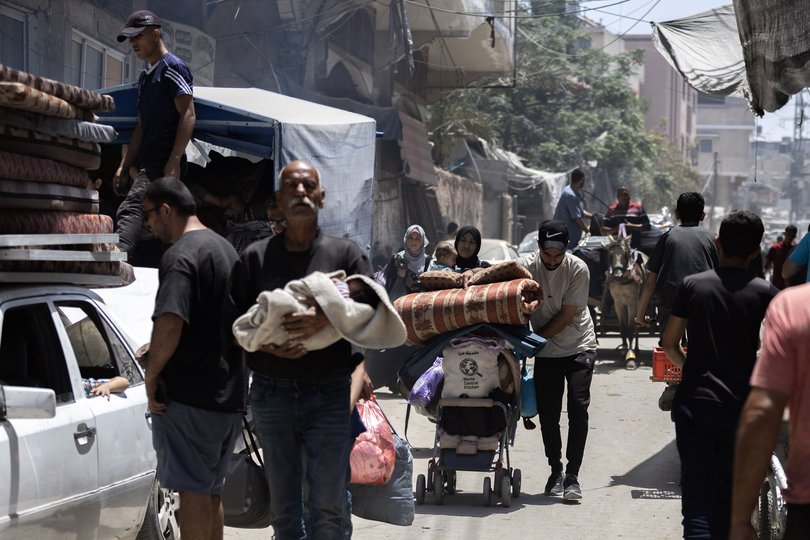THE NEW YORK TIMES: US says Hamas response to Gaza ceasefire proposal ‘only takes us backward’

JERUSALEM — The White House denounced Hamas’ response Saturday to a new U.S. ceasefire proposal as totally unacceptable and said it “only takes us backward” after the group sought firmer guarantees that the deal would lead to a permanent end to the war.
Under the U.S. proposal, which was floated by Steve Witkoff, President Donald Trump’s Middle East envoy, Israel and Hamas would halt the fighting in the Gaza Strip for at least 60 days, during which some hostages would be freed in exchange for Palestinians jailed by Israel. And there would be further U.S.-backed negotiations on a permanent end to the war.
That issue has long been the core sticking point in the truce negotiations. Hamas has been willing to free the remaining Israeli and foreign captives in Gaza in exchange for a guarantee of a lasting end to the war. Israel has vowed to fight until Hamas lays down its arms and sends it leaders into exile.
Sign up to The Nightly's newsletters.
Get the first look at the digital newspaper, curated daily stories and breaking headlines delivered to your inbox.
By continuing you agree to our Terms and Privacy Policy.Witkoff laid the blame on Hamas for the impasse, saying in a statement that its response “only takes us backward.” He said Hamas should accept the U.S. framework as the basis for further intensive negotiations, “which we can begin immediately this coming week.”
A Hamas official outside Gaza had said earlier Saturday that the group was seeking amendments to the Witkoff proposal around the guarantees for ending the war decisively.
An Israeli official said Hamas had demanded stronger guarantees that the temporary truce would pave the way for the end of the conflict that began almost 20 months ago. Both the Israeli and the Hamas officials requested anonymity because of the sensitivity of the topic.

Although Israeli Prime Minister Benjamin Netanyahu says he is willing to reach a temporary ceasefire with Hamas to free hostages, he has ruled out ending the war unless the group meets Israel’s conditions — which the group has rebuffed for the time being.
U.S. officials and other mediators have tried to cobble together a new truce since Israel ended the last ceasefire with Hamas in mid-March. But they have struggled to overcome the basic divide in Israel’s and Hamas’ war aims.
Hamas said Saturday that it had submitted an answer to the proposal that aimed to achieve a permanent ceasefire, bring a full Israeli withdrawal from Gaza, and ensure the flow of aid to desperate and hungry Palestinians in Gaza. The wording indicated that the group was seeking more than the current proposal’s guarantee of a temporary pause in hostilities.
The group said if there was agreement, it would turn over 10 living hostages and the bodies of 18 in exchange for an agreed-upon number of Palestinian prisoners.
About 20 living hostages and the bodies of more than 30 others are believed to still be in Gaza, according to Israeli authorities.
Israel ended a two-month ceasefire in mid-March — citing a deadlock in talks on the next steps in the truce. Israeli forces then resumed attacks in Gaza while blockading humanitarian aid from entering the enclave, a ban that Israel relaxed only last week.
Although Israel and Hamas have both dug into their respective bargaining positions, both sides have also faced rising international pressure lately to halt the fighting.
Palestinians in Gaza, furious over more than a year of war, hunger and bombardment, have held rare protests against Hamas, calling for the group to leave the enclave it has ruled since 2007. And since resuming its offensive in March, Israel has killed several senior Hamas leaders in Gaza.
Israel’s traditional allies, including the Trump administration, have expressed growing impatience and even anger over the protracted war, the dire humanitarian conditions in Gaza that have created a risk of famine, and Israel’s threats to significantly widen the offensive against Hamas.
Israel went to war after Hamas-led Palestinian militants launched the Oct. 7, 2023, attacks on southern Israel, killing about 1,200 people and taking about 250 as hostages, mostly civilians. Israel’s devastating assault in Gaza has killed more than 54,000 Palestinians, according to Palestinian health officials, who do not distinguish between civilians and combatants.
This article originally appeared in The New York Times.
© 2025 The New York Times Company
Originally published on The New York Times
